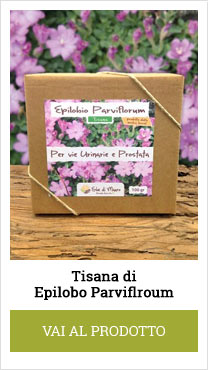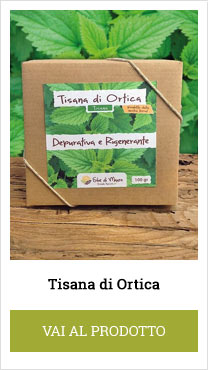
Today I want to talk to you about the epilobium , a medicinal plant, which I think is truly formidable for the resolution of all those disorders affecting the prostate and urinary tract (prostatitis, prostatic hypertrophy, cystitis, etc.) .
In the article I will explain in detail what epilobium is, where it is found and how to recognize the plant (if you want to collect it), where to buy it and above all what are the properties, benefits and uses.
Before starting, however, I would like to make a brief introduction about the variety of epilobium that is best to use.
1. Which to choose? Epilobio angustifolium or parviflorum?
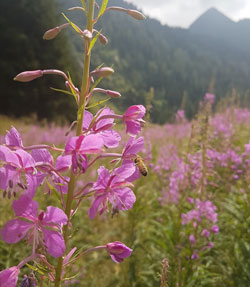
There are numerous varieties of epilobium, but the most studied and most used are:
- epilobium parviflorum (or small-flowered epilobium );
- epilobium angustifolium (or forest carnation).
Now, without taking anything away from the genus angustifolium, which is undoubtedly the plant that is most easily found on the market in the form of capsules and mother tincture, in this article with the term “epilobium” I will refer only and exclusively to the parviflorum variety .
“For what reason?
The reason is simple.
Even before scientific studies, I prefer to base myself on the practical experience gained by doctors and herbalists of the present and of the past , who for years have made use of this medicinal plant.
In particular, one of my main sources is the famous herbalist Maria Treben . Ms Treben, in the use of this plant, has accumulated an experience that very few can boast.
In his book ” Health from the Lord’s Pharmacy ” – a world bestseller translated into 8 languages, with a total circulation of over 8 million copies – the herbalist reports some cases of incredible healings, obtained precisely with the use of the epilobium parviflorum .
Here is a brief excerpt of what he reports in his book, referring to the epilobium:
Its healing power is so great that it often frees all prostate discomfort suddenly . It was the case of some men who were waiting for the operation and who urinated dropwise with great difficulty; a single cup of herbal tea was enough to make them improve . It is understood that the herbal tea should be drunk for a prolonged period to achieve healing.
Still referring to the epilobium, Maria Treben goes on to list some important evidence of the healing of her patients.
Finally he underlines: the variety Epilobio angustifolium should never be used, nor harvested .
Unfortunately, he does not specify the reason, but I trust his wisdom and experience.
While not being able to boast the competence of Maria Treben, in my small way, I can confirm that the epilobio parviflorum gives truly excellent results in the treatment of prostate disorders .
And I see this every day on my clients who use it and share their results with me. And it is thanks to a client of mine that I discovered this plant.
Let me tell you.
2. The discovery of the Epilobium
Until a few years ago I did not know the epilobium at all .
At the beginning I cultivated a few plants and mostly the Aloe Arborescens which I recommend above all for its purifying and immunostimulating properties.
However, through the study and thanks to the suggestion of my trusted collaborators and my most passionate clients ( I admit, sometimes you are more informed than me! ) I gradually discovered new wonderful plants, including the epilobium parviflorum.
In the case of the epilobium it was an old client of mine (thanks Andrea!) To give me the “tip”.
Andrea knew this plant well because he had already used it in the past, precisely to solve an annoying prostatitis that tormented him for months and months.
After realizing that he wasn’t getting any results with the drugs , he made the decision to try “alternative remedies”.
Wandering around the net he found various information on this famous epilobium. It was a natural remedy and with no apparent contraindications.
So why not give it a try?
He then decided to give it a try. I’ll make it short: by regularly drinking 2 herbal teas of epilobium parviflorum a day, in just 2 weeks , he was able to completely eradicate his inflammation in the prostate .
Knowing that I was involved in the cultivation of “strange” medicinal plants, Andrea had the brilliant idea of coming to visit me and telling me his story.
And that day he also sent me this video that I want to share with you. Look at it well, for me it was really enlightening !
The protagonist of the interview is called Josep Pàmies .
He is a Spanish farmer who for years, together with other volunteers, has been running a non-profit association renamed the “Dulce Revolution”.
The association, based in Catalonia, manages huge crops of medicinal plants of all kinds, from all over the globe. And among these there is also the epilobium .
Their goal (which is what I also set myself) is to inform people about the medicinal use of these plants, even for the treatment of difficult or sometimes impossible diseases to cure even for traditional medicine.
The association also collects and shares the testimonies of those who, from time to time, obtain results from the use of these plants.
If you are interested many of these testimonials are published in Spanish on the site: https://dolcarevolucio.cat/language/es/portada/
I can only admire the courage with which Josep deals with this “burning” issue, releasing daily interviews where he often and willingly makes even a little pushed statements, especially towards the pharmaceutical industry and American companies that produce GMO seeds (such as Monsanto).
I invite you to also watch this video to understand what I mean.
3. Properties and benefits of the Epilobium
Main constituents:
- Tannins and related compounds (4-14%): eg. oenothein B, oenothein A, tri-, tetra- and penta-O-galloylglucose
- Flavonoids (1-2%): kaempferol, quercetin, myricetol, etc.
- Phenolic acids and their derivatives : ellagic acid, valoneic acid dilactone, chlorogenic acid, neochlorogenic acid, coumarinolquinic acids, feruloylquinic acids, gallic acid, cinnamic acid, protocatechuic acid, caffeic acid, ferulic acid, etc.
- Steroids (about 0.4%) and triterpenes (about 1.5%): e.g. cholesterol, campesterol, stigmasterol, β-sitosterol, ursolic acid, corosolic acid, oleanolic acid
- Other components : e.g. linoleic acid, palmitic acid, stearic acid, eicosenoic acid, behenic acid, arachidic acid.
How it works
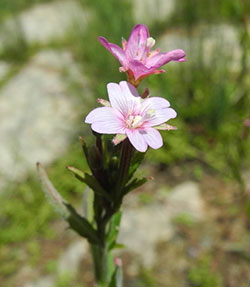
Epilobium has been known and used for years in folk medicine, in the treatment of typical human ailments, such as prostatitis, benign prostatic hypertrophy and all associated urination disorders.
It is also very effective in reducing inflammatory states of the urinary tract, such as cystitis and urethritis .
Gallic acid, bioflavonoids and myricetol-3-0-beta-D-glucuronide, all active ingredients naturally contained in the epilobium plant, exert a powerful anti-edemic and anti-inflammatory action on the prostate and the entire urinary tract, with a strong inhibitory action on prostaglandins.
“What are prostraglandins?
The prostaglandins are substances similar to hormones, naturally present in the human body, derived from linoleic and linolenic essential fatty acids, consisting of 20 carbon atoms, which are the key to numerous biological functions.
They play a very important role in the regulation of inflammatory processes, they increase the sensitivity of the human body to pain and body temperature.
Inhibiting prostaglandins means in simple words, reducing the perception of pain and stimulating the body to produce endorphins (substances similar to opioids with analgesic properties) and reducing inflammation.
Epilobium also contains a high percentage of tannins .
Two of these tannins, enotein A and B , have been identified in various scientific studies as the main components responsible for the inhibition of 5-alpha-reductase and aromatase, enzymes that are believed to play a key role in prostate diseases. including prostate cancer .
Preliminary in vitro studies at the Vancouver Prostate Center showed that very low concentrations of an extract of Epilobium Parviflorum, at the level of micrograms per ml, were found to be among the most effective active ingredients most effective against the development of abnormal cells and the consequent enlarged prostate.
In summary: for which ailments is epilobium useful?
For the reasons listed above, the epilobium is particularly effective in case of:
- difficulty urinating;
- pain / burning sensation while urinating;
- feeling that the bladder has not emptied completely;
- the need to go to the bathroom several times during the night;
- decreased sexual desire (due to pain);
- and in some rarer cases, impotence.
Since it contains tannins, epilobium is also useful in case of internal bleeding of various kinds, such as gastric ulcers , bleeding haemorrhoids or in the case of an excessively abundant menstrual cycle .
Also due to the high presence of tannins, it also has an effective anti-diarrheal action, so that the epilobium, especially if in association with nettle, is very useful for blocking cases of diarrhea .
4. Where to collect Epilobium parviflorum and how to distinguish it from angustifolium
Before where, when is important .
The epilobium is harvested only and exclusively in a specific period of the year, which corresponds to the flowering period , or in the height of summer , between July and September.
Flowering corresponds to the balsamic period of the plant, that is the moment in which the epilobium develops its active principles to the maximum.
What to collect ?
Everything is collected from the epilobium: the stem, the leaves and the flowers .
Where does the plant grow?
Epilobium angustifolium (which should not be harvested) grows mostly in the high mountains, in pastures, in prairies or in the vicinity of rivers and streams.
Epilobium parviflorum grows in almost all of Italy, even at low altitudes up to 1,400 m of altitude. It is a plant that loves humid places and which develops mainly along the banks of rivers, ditches and streams.
How to distinguish the two plants?
During the flowering period, these two varieties of epilobium are easily distinguished.
L ‘ epilobium angustifolium is a plant that can reach and exceed one meter and a half in height and which is immediately recognizable by showy flowers goblet-shaped, of a heated fuchsia.
Observing the flowers from afar, it almost seems to admire a sea tinged with pink. A real feast for the eyes!
L ‘ epilobium parviflorum looks like a little plant that usually does not exceed 60-70 cm in height. The leaves are narrower and the flowers are really tiny, a very pale pink and violet color.
Basically they are two completely different plants, it is practically impossible to get confused. Below are two photos that will further help you in recognition.
In order first the epilobium parviflorum, then the angustifolium:
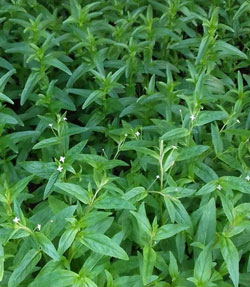
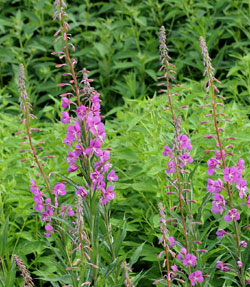
5. Contraindications
Epilobium is a well tolerated remedy and has no particular contraindications.
However, it is recommended not to use it during pregnancy , or while breastfeeding .
Finally it is contraindicated in case of ascertained hypersensitivity towards the plant.
6. How to use the Epilobium
The classic method of using epilobium is as an herbal tea and it is the method that also Maria Treben recommends.
In the summer, if you have the possibility, you can prepare the herbal tea with the fresh plant, or you can use the dried plant.
In both cases, the entire aerial part of the plant is used: leaves, flowers and stem.
To prepare the herbal tea, add a teaspoon of dried epilobium (2 tbsp if you use the fresh plant) to a cup of hot, almost boiling water (about 250 ml).
Leave to infuse for about 8-10 minutes and then filter.
It is preferable to drink 2 cups a day , the first in the morning on an empty stomach, the second half an hour before going to bed.
How long should the herbal tea be taken?
At least until the symptoms disappear completely.
7. Where to buy Epilobium parviflorum
You can buy the epilobium parviflorum herbal tea directly from my farm.
It is a plant that we grow in the open countryside, in the hills of Fermo, in the Marche, with absolutely natural methods, without the use of herbicides, pesticides, herbicides or chemical fertilizers.
The harvest of the epilobium is then carried out between July and August.
The flowers and leaves are dried in a natural way, in the shade and in a constantly ventilated area, to avoid the formation of mold.
Finally, the dried plant is finely shredded and bagged.
There are no means of intermediation. From the earth the product arrives directly at your home , pure and natural as mother earth did it.
If you are interested, you can order the epilobio herbal tea directly from our website, by clicking here: https://www.erbedimauro.it/en/herbal-teas-and-dried-herbs/80-epilobium-parviflorum-herbal-tea.html
Epilobium parviflorum herbal tea 100g
- Ingredients: Epilobium parviflorum, dried leaves and flowers;
- Pack of 100 gr;
- Italian product;
- Company: Erbe di Mauro.
8. Other remedies for the prostate
In order to enhance the curative effects of epilobium, other equally effective natural remedies can be associated with the therapy, such as:
- Nettle herbal tea .
nettle is especially useful in the case of benign prostatic hypertrophy, because it helps to reduce the size of the prostate, thus facilitating urination. Both the leaves and the root can be used. At least one cup a day of this herbal tea - Bee pollen .
There are several studies that confirm that the consumption of bee pollen is effective in fighting prostatitis and prostatic hypertrophy, as it would reduce pain and inflammation, inhibiting the proliferation of prostate tissue. At least 1 teaspoon per day is recommended.
Related products:
NB : All information published on this site is informative and should not be considered as advice, or medical prescriptions, or other.


